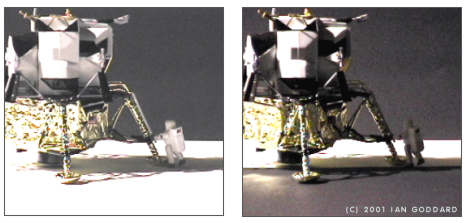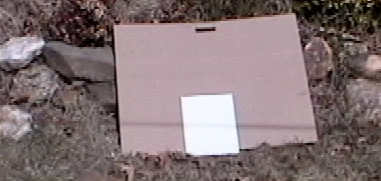|
02/26/2001 Ian Williams Goddard The program Conspiracy Theory: Did We Land on The Moon? seen on FOX television network (2/15/01) advanced the claim that NASA's Apollo Moon missions were a giant hoax. The claim was largely supported by alleged "anomalies" in Apollo photos. David Percy, an Associate of the Royal Photographic Society, told FOX: "Our research suggests that images of the Apollo landings are not a true and accurate record. In our view the Apollo pictures were faked. Many of the images are replete with inconsistences and anomalies." Are Percy and other Apollo skeptics correct? Let's examine their claims. Examination of Apollo-Photo "Anomalies" Illumination in Shadow: FOX narrator: "On the Moon, the astronaut's only source of light was the Sun. ... Here's an astronaut who descends into the huge shadow caste from the lunar module, yet his entire body is still visible. How is it that he is not shrouded in darkness?" Apollo skeptic answers: "It's because there's more than one light source, which means they're not on the Moon." 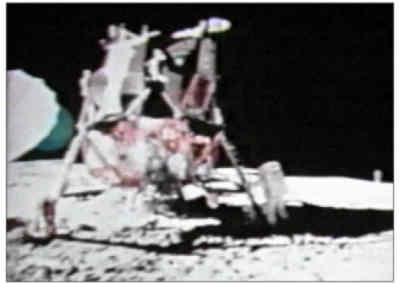
Question: why is the astronaut in the shadow illuminated? Answer: surface reflection of light:
The two side-by-side photos show a test I conducted with a model of the lunar module and a toy astronaut placed in its shadow as in the Apollo image above. The two photos show the difference between a reflective gray-paper foreground and a less reflective black-paper foreground. Foreground reflectance from the powerful lamp above was sufficient to illuminate the toy astronaut in the shadow of the toy lunar module. This simple test demonstrates that Apollo astronauts illuminated in shadow are not an "anomaly" but a predictable result of sunlight reflecting off the sunlit lunar surface. FOX narrator: "In this picture the Sun is directly behind the astronaut, his figure should be a silhouette, yet even the smallest characteristics of his suit are recognizable." A photographic expert then says: "He seems like he's standing in the spotlight. I can't explain that." Here's that Apollo astronaut in the first of these three photos: 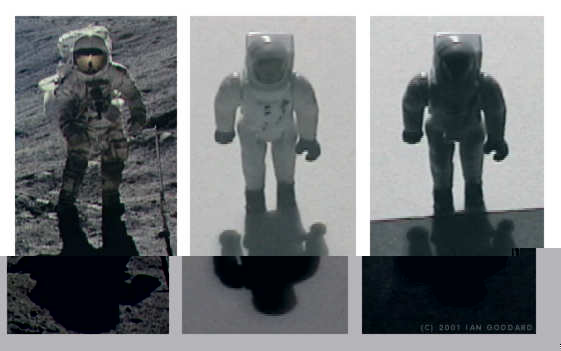
Illumination of Apollo astronaut on left simulates surface reflection on toy. The toy-astronaut test shows us the difference between a reflective foreground (gray paper) and a less reflective (black paper) foreground. Apart from surface reflection, the only light source was the lamp behind the toy. These tests show that illumination of astronauts in shadow is not an anomaly but a predictable result of surface reflection. In addition to the Sun and surface reflection, light from the Earth in the sky above the Apollo astronauts was 68 times brighter than a full Moon seen from the Earth. [1] Different Shadow Directions FOX narrator: "On the Moon, the astronaut's only source of light was the Sun. Yet in this photograph from Apollo 14, the shadows are caste in different directions suggesting multiple light sources." Dave Percy: "The shadows caste by the rocks in the foreground should have been east-west like the LEM [lunar module] shadow." 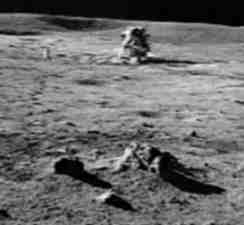
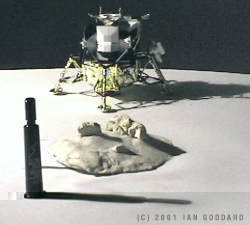
Test: slanted surface alters shadow direction on Moon-rock model under one light. Identical ground slant can be detected in Moon photo on left. The photo on the right shows one light shining on a clay model of Moon rocks and ground. This test simulates the shadow "anomaly" in the Apollo photo and demonstrates that ground slant -- in addition to light source and viewer position -- is an important factor in shadow direction. The LEM in the background and the magic marker in the foreground serve as shadow controls, showing the direction shadows on non-slanted ground run in the area. The direction of model-rock shadows differs from control, running downhill with the slant of the ground upon which their shadows are caste. (Note: the toy LEM in the background is further from the lamp in weaker light than in the first test, yet the toy astronaut on it is still illuminated in shadow by surface reflection.) 
Other examples in Apollo photos of shadows following ground slant. On left shadows run down crater. On right run down Hadley Rille. Just as the shadows follow the topography of the lunar ground in these two examples, the alleged shadow "anomaly" in the previous Apollo photo is clearly a result of ground slant and therefore is not a genuine anomaly indicating fakery. Apollo skeptics cite other examples of shadow-direction "anomalies," all of those I've viewed are obviously a result of irregular ground slant. Identical Backgrounds FOX Narrator: "These two photos seem to have the same mountain backdrop, yet the lunar module is only visible in one of them. Seemingly impossible since the LEM never moved, and its based remained even after the mission. Some suggest the same artificial backdrop was used when shooting two entirely separate pictures." 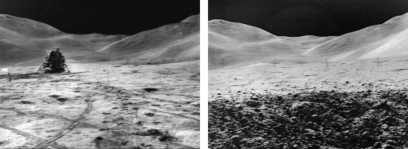
Examination of the photographic archive of the Apollo 15 mission clearly proves that the mountains in the background are large and distant enough that they can be seen and look similar from myriad points of view with or without the LEM in the foreground. [2] The mountains we see above are the Apennine Front on the left side of each photo and Mount Hadley Delta to the right in each. [3] Apollo 15 astronauts went up to those mountains and walked on Hadley Delta. How could they enter a fake backdrop? These lunar surface panoramas A & B (scroll right) are assembled from single photos and show Apollo-15 astronaut David Scott at the base of Mount Hadley Delta with the Apennine Front behind him. Here is another view of the Apennine Front from the slope of Hadley Delta. Here is a panorama with the fresh crater in the foreground seen above. Here are some other views of these mountains for various locations: A, B, C, D, E, F, G, H. Those photos show that the known and mapped lunar mountains in question are not a fake backdrop but are real three-dimensional mountains around the astronauts. The lunar mountains in question are seen in the following 360-degree panoramic view of the Apollo 15 landing site. |

|
This panorama, a composite of multiple single photos, shows that the Apennine Front and Hadley Delta can be viewed without the LEM in the foreground, since when the camera views them at 180 degrees (as marked below the panorama), the LEM is behind the camera at 0 degrees, out of the picture frame for that photo. The panorama also gives a sense of how far the mountains are. Because there is no atmosphere on the Moon, objects do not become faded-out over distance and thus far-away mountains can appear very close, as they do in the two photos FOX showed. The claim that these known and mapped Moon mountains that are viewed from myriad angles in Apollo photos [2] are really a fake backdrop that was accidently used in two staged studio sets on Earth is not a theory but an exercise in silliness. BadAstronomy.com explains the other example FOX presented of an alleged identical background "anomaly." [4] Crosshair Knockout FOX narrator: "For reference, crosshairs were permanently etched into the lunar cameras, so they would have to appear on top of every image. But in this photo, a crosshair is behind a part of the lunar rover." David Percy then opines: "This situation is impossible and has to be the result of technical manipulation and doctoring of the image." Clue: in each example FOX showed of an object appearing to be over a crosshair, the obtrusive object was sunlit and bright white, such as these examples: 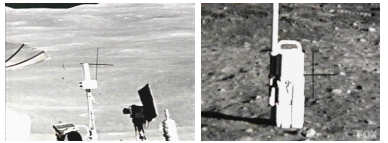
Question: why do crosshairs vanish over sunlit white objects? Answer: strong luminosity can washout thin lines.
In this test a strand of hair was taped across a camcorder lens, which was then pointed at a sunlit white paper. While my test failed to vanish the hair-line completely, it demonstrates that diffuse solar reflection on a white surface can wash out a thin line. This result is sufficient to render the phenomenon of crosshair vanishing over sunlit white objects not anomalous. It should be noted further that reflective luminosity and thus the potential to fully vanish crosshairs would be much greater on the Moon than in my test since the Moon has no atmosphere reducing solar intensity. Conclusion: None of the alleged photographic anomalies presented during FOX's "Moon hoax" program are genuine anomalies and thus they are not evidence of photographic manipulation or a giant hoax. In the near future Goddard's Journal shall examine alleged physical anomalies said to be evidence that man never set foot on the Moon and shall examine the overwhelming evidence indicating that the Apollo missions were genuine. In the meantime, other claims from Apollo skeptics are presented and addressed at the websites linked-to below.
[1] Fortean Times: Percy and the Astro-Nots. 1997. [2] Apollo 15 Digital Picture Library & JSC Digital Image Collection. [3] NASA Photo ID: AS15-82-11057 [4] BadAstronomy: Fox TV and the Apollo Moon Hoax. 02/12/2001. Websites Refuting Hoax Claim
Sites Promoting Hoax Claim
|
